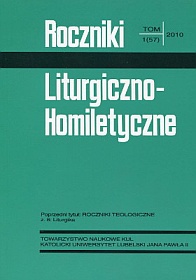The Hispanic Mozarabic Rite
(transl. by Rev. Piotr Roszak)
Abstract
The article tackles the issue of the theological structure of the revived Hispanic Mozarabic rite that had been formed in the Iberian Peninsula in the vicinity of the three metropolitan sees: Seville, Toledo and Tarragona. Formation of the rite was a long process, in which a prominent role was played by the great Spanish theologians, with St Isidore of Seville and St Ildephonsus of Toledo in the foreground. Suspended under the influence of Romanization of the native liturgy in the 11th century, it survived only among the Christians who lived in the areas dominated by Muslims, and after Toledo was liberated in 1085 King Alfonso VI allowed using the Hispanic Mozarabic rite in six parishes of the town. After the Vatican Council II, under the direction of the Archbishop of Toledo Cardinal Marcelo Gonzalez, the superior of the Hispanic Mozarabic rite in Spain, a revision and publication of liturgical books of this rite was begun. In its basic structure the Eucharist in the Hispanic Mozarabic rite is constituted by: a) introductory rites; b) Liturgy of the Word; c) Offertory – the Diptychs – the sign of peace; d) Eucharistic prayer; e) Communion rites. The author discusses each element of the Eucharistic liturgy of the rite in detail and he points to the exceptional features that distinguish it from the Roman liturgy: the euchological exuberance, the symbols, the interventions of the congregation, the wealth of the Liturgy of the Word, the peace rite through the Eucharistic liturgy, the presence of the Diptychs, and the gesture of the breaking of the bread that remembers the mysteries of Christ’s life.
References
Conrad J.: Die altspanische Liturgie in Toledo als Ausdrucksform mittelalterlichen Landeskirchentums. „Jahrbuch für Liturgik und Hymnologie” 41:2002 s. 54-67.
Ivorra A.: Liturgia hispano-mozárabe. Teología de las “illationes” cotidianas del Missale Hispano-Mozarabicum. „Toletana” 15:2006 s. 23-48
Moldovan T.: Relación entre anáfora y lecturas bíblicas en la cuaresma dominical hispánico mozárabe. Salamanca: Universidad Pontificia de Salamanca 1992.
Ramos-Lisson D.: Relación entre el sacrificio eucarístico y el sacrificio de la Cruz según el ‘Liber Mozarabicus Sacramentorum’. „Scripta Theologica” 4:1972 s. 499-521.
Rincon M.: Mozárabes y Mozarabías. Salamanca: Ediciones Universidad de Salamanca 2003.
Robles Garcia C.: La liturgia mozárabe. W: Breviarium Goticum secundum Regulam Beatissimi Isidorii. Red. J. Paniagua. Leon: Universidad de Leon 2004.
Viguera V.: La ‘anamnesis’ en la anáfora de la antigua liturgia visigótica. „Communio” 15:1982 s. 47-71.
Tomás Cánovas I.: Teología de las celebraciones del tiempo de Navidad en la liturgia hispano mozárabe reformada en 1991. Barcelona: Grafite Ediciones 2002.
Woolfenden G.: La oración diaria en la España cristiana. Estudio del oficio mozárabe. Salamanca: Ediciones Cristiandad 2003.

